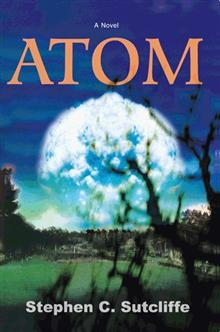ATOM
Fear and paranoia surrounding the atomic bomb is explored in Stephen C. Sutcliffe’s ambitious yet meandering novel, Atom.
Thanks mostly to the limitless funds of their affluent parents, Michael Brethren and his friends live a free and easy life with few responsibilities and plenty of drugs and rock ‘n’ roll. During the summer of 1978, their collective ennui leads to hours of pontificating and bemoaning their misfortune—namely, that they live in a nuclear age in which the deadly power of the atomic bomb could be unleashed at any time. Calling themselves the Children of Atom, their paranoia and resentment lead them to construct a plan for unleashing a bomb on their unsuspecting town to prove their point. The potential incidental deaths of innocent people barely seem to register with any of them, and Atom follows the four friends as they plot their goal of wreaking the havoc they claim to fear.
In spite of their parental financing and money earned from selling drugs, Michael and his friends still have nowhere near the amount of money required to purchase the plutonium they need. Their solution is to steal from, and then eliminate, a Mexican drug dealer, which they accomplish with astonishing success. The remainder of the escapade is filled with chaos and confusion.
Sutcliffe’s novel is often difficult to follow. The plot line, in which a group of wealthy and entitled young men indulge their fantasies of social justice, is unfocused and murky. The prose meanders from one moment to the next, sometimes becoming lost in a character’s diatribe or frenzied imagination. Dialogue is often unnatural, and simplicity is sacrificed in favor of a unique turn of phrase, such as descriptions of the ocean as “warm, embryonic sea” or “the astonishing evacuation of stress” as Michael “wrought lead guitar phrases.” Such overdone verbiage may ultimately frustrate readers.
The novel also suffers from a lack of editorial attention. Emphasis is conveyed with up to twelve exclamation points or question marks, and phrases are occasionally boldfaced to stress importance. One chapter is a flashback to a Q&A session in Michael’s Humanities class, and appears to exist solely to describe the protagonist’s character in the fastest way possible.
There are parts of the novel that are well written and compelling, particularly the action scenes. When the writing is toned down to a more simple level, it often succeeds, as in this description of a character: “John was heavy-set, yet lithe, his eyes and expression twisted in a riveting guise of indiscriminate condescension.”
Every novel must have at least one character that readers can connect with, but Atom lacks sympathetic central characters. Michael’s friends are even more self-centered than he is, and one of them seems to fully enjoy his homicidal exploits. Characterization lacks the depth to convey any of the four plotters as much more than spoiled rich kids with little conscience.
Atom has the potential to be reworked into an interesting tale with an increased emphasis on engaging characterization. As it stands, the story is likely too unfocused and lacking in sympathetic protagonists to appeal to a large audience.
Reviewed by
Jeannine Chartier Hanscom
Disclosure: This article is not an endorsement, but a review. The publisher of this book provided free copies of the book and paid a small fee to have their book reviewed by a professional reviewer. Foreword Reviews and Clarion Reviews make no guarantee that the publisher will receive a positive review. Foreword Magazine, Inc. is disclosing this in accordance with the Federal Trade Commission’s 16 CFR, Part 255.

